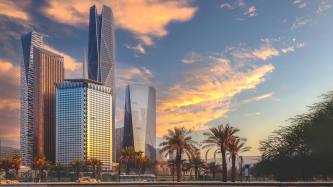As the world’s largest exporter of crude oil, Saudi Arabia is set for a watershed year in 2022. Prices have reached their highest in almost 14 years, on the back of Russia’s invasion of Ukraine in February, and are holding above $100 at time of writing.
The country’s economy is set to reap the benefits of both high prices and any gradual increase in production in 2022, with other global oil producers either unable or unwilling to commit to further increases in supply for the rest of the year. This gives Saudi Arabia its strongest economic growth in 11 years and a return to economic surplus for the first time since 2014.
“Higher global oil prices and rising production volumes, alongside a recovery from the Covid-19 pandemic, are supporting Saudi Arabia’s fiscal and gross domestic product [GDP] growth dynamics, as well as its already strong external metrics,” wrote S&P Ratings in late March. The agency upgraded its outlook for the country to positive from stable.
The exceptional economic windfall may prompt the government to ease recent fiscal constraints, and is set to bankroll a series of megaprojects – especially in tourism and hospitality. These form the backbone of the country’s ambitious Vision 2030 social and economic transformation programme.
Luring investors
Saudi Arabia’s opening up to the world remains a work in progress, despite eye-catching economic and social reforms. Of particular note is the struggle to lure foreign investors to the country, given that the government is hoping to gain $100bn in foreign direct investment (FDI) per year by 2030. However, overseas investors remain wary of such large commitments, monitoring further reforms as well as reputational and security risks.
Barely two years ago, the beginning of the Covid-19 pandemic – and a short-lived price war with Russia – drove prices to an 11-year low. Oil prices began their steady recovery in late 2020 as vaccine rollouts prompted a recovery in the global economy. Further rises in late 2021 to above pre-Covid levels are a result of supply-side fears. Russia’s invasion of Ukraine sent prices surging to as high as $139 a barrel in late February, remaining above $100 since then.
Prices are set to average $102 per barrel in 2022-2023, according to Bank of America, with spare capacity among Organization of the Petroleum Exporting Countries (Opec) producers sitting at around 2.5 million barrels per day, leaving little buffer for additional shocks. The Opec+ block of global producers – dominated by Saudi Arabia and Russia – confirmed at its meeting on March 31 it would not deviate from its plan to increase production gradually through 2022.
Saudi’s GDP growth, which recovered to 2.8% in 2021 after contracting by 4.1% in 2020, is now set to surge to 9% in 2020, according to Capital Economics (see chart). While the Saudi government forecast a surplus – its first since 2013 – of SR90bn ($24bn) or 2.5% of GDP in its budget announced in December (based on an average oil price of $75 for the year), this is set to increase to 15% of GDP, Capital Economics predicts.
Confidence stays high
While the Saudi government has in recent years moved to weaken the relationship between oil revenues and fiscal policy, speculation is rising that authorities may make an exception following austerity measures put in place during the Covid-19 pandemic.
The ministry of finance announced around SR100bn-worth of austerity measures in May 2020, including an increase in VAT from 5% to 15% and the cutting of a SR1000 monthly cost of living payment for government employees.
“Given the oil-related windfalls we forecast in 2022 and 2023, it is not inconceivable that the government could opt for some one-off measures to support the population, which could lead to an increase in expenditure,” said S&P in its report.
Even ahead of such measures, consumer and business confidence remain elevated; Saudi consumer confidence rose to an all-time high in March, according to Ipsos’s Primary Consumer Sentiment Index (PCSI), while non-oil Purchasing Managers' Index (PMI) data compiled by S&P hit its highest level since November on the back of marked expansions in output and new orders.
Also on the rise, however, is inflation. In addition to the impact on oil and gas prices, the ongoing conflict between Russia and Ukraine – two of the Middle East’s largest wheat suppliers – is set to significantly raise food prices across the region.
While less reliant on imports from the two countries than some, Saudi Arabia sourced around 45% of its wheat from Russia and Ukraine in 2021, and has seen import costs rise 40% so far this year, according to Jadwa Investment.
“That said, with the US Federal Reserve raising interest rates by 25 basis points recently, and indicating an aggressive path to further hikes during the remainder of the year, we expect the value of the dollar (and therefore the Saudi riyal) to rise, which should help insulate the kingdom’s import costs somewhat during the year,” said Jadwa in its first-quarter inflation update.
The government has already acted to curb transportation inflation, with a freeze on local fuel prices put in place in July 2021. While Jadwa recently upgraded its inflation forecast for 2022 to 2.4% from 1.7%, this still represents a decline from the 3.1% recorded in 2021.
Vision 2030
Saudi’s oil windfall is a boost for Vision 2030, the country’s ambitious economic and social transformation programme, unveiled in 2016 by the country’s crown prince (and de facto leader) Mohammed bin Salman. Gigaprojects launched under the scheme thus far include Neom, a 26,000 sq km project on the Red Sea coast that connects to Jordan and Egypt, a $10bn Red Sea tourism development, and sports and entertainment centre Qiddiya.
In a shift up in gear, in October the government announced its National Investment Strategy (NIS). The scheme, which envisages SR12.4tn-worth of investment in the domestic economy by 2030, intends within that timeframe to raise the private sector’s contribution to GDP to 65% and increase the contribution of non-oil exports to GDP from 16 to 50%.
One of the key aims of the NIS is to attract $100bn in annual FDI by 2030. Such a target is ambitious at best given the failure to attract significant investment in the first six years of Vision 2030; the scheme’s original aim was to attract nearly $19bn in FDI by 2020, but less than a third of that amount was raised.
While high-profile incidents such as the murder of Washington Post journalist Jamal Khashoggi and sporadic attacks by Houthi rebels in Yemen have alarmed would-be international investors, the relative challenges of doing business in the country remain the biggest deterrent to foreign investment, according to James Swanston, a Middle East and north Africa economist at Capital Economics.
“The main factor is that the local business environment is still not conducive enough to new entrants, including set-up fees and the importance of knowing the right people,” says Mr Swanston. “A lot of action still needs to be taken to make it more hospitable to foreign investors, particularly in competition with Dubai.”
In recognition of the competition from Dubai and other competing regional business hubs, the Saudi government announced in February 2021 that it would only award contracts to foreign companies that have their regional headquarters in the country from 2024 onwards.
With Saudi Arabia’s economy improving steadily since late 2020, FDI has begun to show signs of growth, albeit far below even Vision 2030’s original, less ambitious targets. The kingdom reported inflows of $19.3bn in 2021, its highest level in more than a decade and a 257% increase on the previous year, according to the ministry of investment.
While $12.4bn of that figure came from the offloading by state oil firm Saudi Aramco of a 25% stake in its oil pipelines business, inflows for each of the five quarters to the end of 2021 were higher than at any time during the past five years. Meanwhile, the country issued 4439 foreign investment licences in 2021, predominantly in the wholesale and retail, manufacturing and construction sectors, and more than in the previous four years combined.













